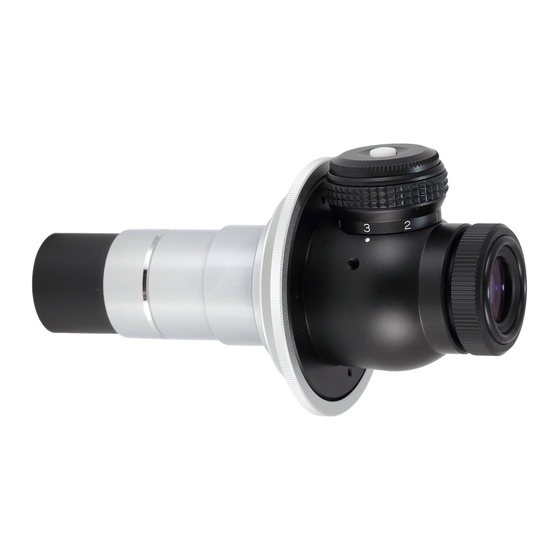
Advertisement
Quick Links
Advertisement

Summary of Contents for Vixen PF-L II
- Page 1 Instruction Manual for PF-L II Polar Alignment Scope...
-
Page 2: Allgemeine Warnhinweise
Allgemeine Warnhinweise Read the safety instructions and the operating instructions carefully before using the appliance. Keep these operating instructions in a safe place for future reference. If the appliance is sold or passed on, the operating instructions must be passed on to any subsequent owner/user of the product. Respect the privacy of those around you - do not look into flats with this device, for example! DANGER of bodily injury Never look directly at or near the sun with this unit. -
Page 3: Components Guide
Polar Alignment Scope If your intention is to take long exposure astrophotography, you must accurately align the polar axis (R.A) of the mount to the celestial pole. This requires the use of a polar alignment scope. The polar alignment scope can align the polar axis of the mount as accurately as 3 arc minutes or less. -
Page 4: Replacing The Battery
Replacing the Battery While holding the brightness adjusting dial by hand, remove the battery cover Battery cover (the switch for illuminator) on the top of the brightness adjusting dial by turning it counterclockwise. Turn the battery compartment on the polar alignment scope downward as shown in the fi gure so that the old Brightness adjusting dial battery can fall out of from the battery... - Page 5 Polar Alignment in the Northern Hemisphere The polar axis of the AP equatorial mount is aligned to the North Celestial Pole in the northern hemisphere. The polar alignment scope utilizes 3 stars of Polaris, Delta UMi and 51 Cep near the North Pole. Positions of the above stars are plotted on the reticle of the polar alignment scope.
- Page 6 Open the round window on the declination body by sliding down the shutter of the window. While looking into the polar alignment scope, turn the polar alignment scope body so that the engraved Big Dipper (or Cassiopeia) on the reticle matches the Big Dipper (or Cassiopeia) in the real sky.
- Page 7 While looking into the eyepiece of the polar ★ Celestial north ★ Celestial north alignment scope, adjust the direction of the mount by turning the altitude adjustment bolt and azimuth adjustment knobs so that Polaris comes as close as possible to the designated position on the reticle.
- Page 8 Polaris is out of place from the designated position. This is part of the process. Center of the polar alignment scope’s field of view (Center of the rotational axis of the equatorial mount) Celestial north Celestial north Turn the polar alignment scope body so that Delta UMi comes near Since there is no mark that points at the North Celestial Pole, you to the location of the year 2014 on the scale.
- Page 9 While looking into the eyepiece of the polar ★ Celestial north ★ Celestial north alignment scope, turn the altitude adjustment bolt and azimuth adjustment knobs so that Polaris comes to the gap between the two segments of the lines marked 2014 and 2040.
- Page 10 Polar Alignment in the Southern Hemisphere The polar axis of the AP equatorial mount is aligned to the South Celestial Pole in the southern hemisphere. The polar alignment scope utilizes 3 stars of Sigma Octantis, Tau Octantis and Chi Octantis near the South Pole. Positions of these star are plotted on the reticle of the polar alignment scope.
- Page 11 Open the round window on the declination body by sliding down the shutter of the window. While looking into the polar alignment scope, turn the polar alignment scope body so that the engraved Southern Cross (or Alpha Eridani) on the reticle directs the Southern Cross (or Alpha Eridani) in the real sky.
- Page 12 ★ Celestial south ★ Celestial south While looking into the eyepiece of the polar alignment scope, adjust the direction of the mount by turning the altitude adjustment bolt and azimuth adjustment knobs so that Sigma Octantis comes as close as possible to the designated position on the reticle.
- Page 13 Now, Sigma Octantis gets out of place from the designated position but it is not necessary to correct for it at this stage. Celestial south Celestial south Center of polar the alignment scope´s field of view (Center of the rotational axis of the equatorial mount) Since there is no mark that points at the South Celestial Pole, you Turn the polar scope body so that Tau Octantis comes near to the need to match the polar axis of your AXJ mount with the S.C.P.
- Page 14 While looking into the eyepiece of the ★ Celestial south ★ Celestial south polar alignment scope, turn the altitude adjustment bolt and azimuth adjustment knobs so that Sigma Octantis comes to the gap between the two segments of the lines marked 2014 and 2040.
- Page 15 Tips on Finding Octans The constellation Octans is made up of dark stars about 5th magnitude on average. The nearest star to the south celestial pole is Sigma Octantis, which is one of four stars forming a trapezoid in Octans, visible at 5.5th magnitude. There are a few methods to locate inconspicuous Octans using the surrounding stars.
- Page 16 VIXEN - European Distributor: Bresser GmbH | Gutenbergstrasse 2, D-46414 Rhede, Germany Phone: +49 (0) 2872 – 80 740 E-Mail: info@bresser.de www.bresser.de Manual_X000327_PS-L-II-Polsucher_en_Vixen_122021.indd...






Need help?
Do you have a question about the PF-L II and is the answer not in the manual?
Questions and answers